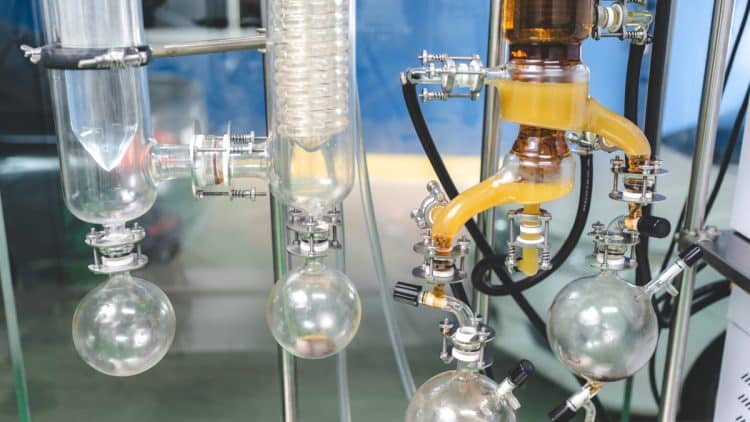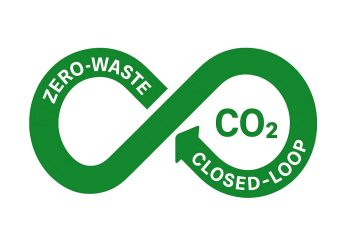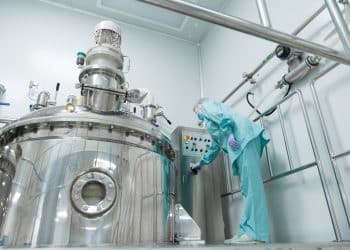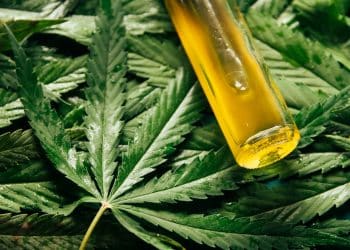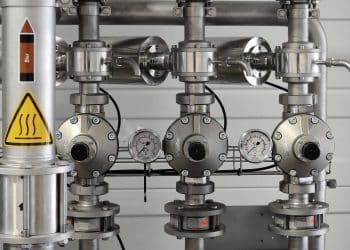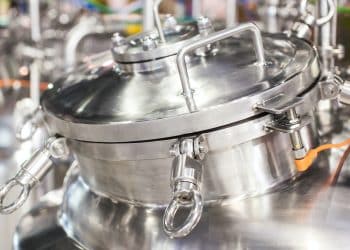Distillation technique dates back to ca. 3500 B.C. [1] The development of methods of separating mixtures into their components started alongside alchemy in the 9th century A.D. in the Middle East. This pseudoscience had as its goal the production of elixirs. At the base of these drinks there were extracts that could also undergo separation processes. [2]
From that moment on, simple and fractionaldistillation was used and perfected up to the present day. Research applications include separation and purification of organic compounds. Moreover distillation techniques are widely used in industrial crude oil refineries, distilleries for the separation of alcohols from fermented liquids, for water purification or desalination, and also for other applications.
Distillation
Distillation is an ancient unit operation. Early applications used crude extract vaporization and condensation equipment, often for concentrating the alcoholic content of beverages. [3]
This process appears to have been utilized by the earliest experimentalists: Aristotle (384–322 B.C.) mentioned that pure water is made by the evaporation of seawater, Pliny the Elder (23–79 AD) described a primitive method of condensation in which the oil obtained by heating rosin is collected on wool placed in the upper part of an apparatus known as a still. [4]
Two subsequent state transitions are the basis of distillation: evaporation/boiling and condensation. Every solid or liquid substance has a characteristic vapor tension or pressure that increases as the temperature increases. When the vapor pressure equals the external atmospheric pressure, the liquid begins to boil.
The separation of a mixture by distillation occurs because the vapor has a different composition from that of the liquid from which it distills and is richer in the most volatile component, i.e., the one which has the lowest boiling temperature. This vapor can be cooled and separated from the initial mixture by condensation. [5]
Distillation set-up
This practice can be performed by using:
- Hot-plate stirrer or Heater (Bunsen burner or hot water bath)
- Still pot
- Thermometer
- Condenser
- Collector
Hot-plate stirrer
The magnetic stirrer is used to simultaneously mix and heat liquid solutions.
Heater
The famous laboratory gas burner associated with the name of the German chemist, Robert Wilhelm Bunsen (1811–1899), was first described in detail in 1857. An examination of the paper by Bunsen shows that his primary reason in using the new burner was to obtain a virtually colorless, soot-free flame of constant size that could be used to establish photometric standards in inorganic chemistry essays. The burner also provided a hotter, more concentrated flame for conventional laboratory use. By the end of the 1860s, laboratory gas burners had largely displaced the older charcoal furnaces that had dominated chemistry for most of its recorded history. [6]The hot water bath is preferred for heating flammable chemicals to prevent ignition.
A thermal coat can be used to provide a uniform heating.
Still pot
Round bottom flask or vessel, made of Pyrex glass. Once the solution is heated, the mixture begins to boil, to proceed with the distillation. The volume of the flasks depends on the volume of the mixtures (from 100 ml up to 500 ml or even more).
Fractionating column
The small scale apparatus composing the fractional distillation equipment includes a column of laboratory glassware. It is placed between the flask and the condenser. The thermometer is placed at the top of the column to measure the evaporation temperature of the fraction being collected. [7]
In contrast to what happens in simple distillation, the vapor continues repeating several times the evaporation/condensation/evaporation process to improve the separation efficiency. The rectification columns are often filled with glass beads or may present particular designs (like Vigreux column) to increase the surface area available for condensing the vapor. [5]
Increasingly lower temperatures are established along the column as one moves away from the flask where the initial mixture boils. Thanks to these temperature steps, called theoretical plates, it is possible to achieve complete separation of the initial components.
The number of theoretical plates necessary for a complete separation of the liquids depends on the difference between the boiling temperatures: the greater the difference, the smaller the number of plates and therefore the shorter the rectification column can be. [5]
Thermometer
It is used to control the vapor temperature of the distilled fraction. It is used to control the vapor temperature of the distilled fraction. These data are discriminating for a primary classification of the identity of the extracted compounds. The thermometer can be put at the top of the flask in the simple distillation, or on the top of the column in the fractional distillation.
Condenser
This part is simply responsible for the condensation of the distilled fraction that is collected.
It is a glass tube presenting a freshwater input, close to the vapor source, and a warmer water output, close to the collector. [5]
In simple distillation it is linked to the still pot and provides the separation granting a thermal gradient. In fractional distillation it is used to condensate the vapor of the high volatile compounds because the fractionating column itself provides the separation.
Today’s design presents a variety of condensers, more intricate means more cost. But for different separation conditions we can find bubble or even spiral structures.
Collector
Laboratory flasks or beakers, used to collect different portions or fractions of the mixture. From these it will be possible to analyze the content of the initial mixture. [5]
Applications
Simple distillation is performed for thermally stableliquids with boiling temperatures between 35 and 105°C and which have high differences between boiling temperatures.
It is a general term for the vast majority of distillation techniques used in business and laboratory research. [8] The most popular applications are in the Food and Beverage industry or Extractive industry with purification goals.
Fractional distillation is performed for mixtures of volatile and miscible liquids characterized by relatively close boiling temperatures (difference around 25°C) or for complex mixtures of liquids. Industrial applications in oil refining, in alcohol, perfume and pharmaceuticalmanufacturing, but also can provide airseparation.
References:
- Nicholas A. Weires, Aubrey Johnston, Don L. Warner, Michael M. McCormick, Karen Hammond, and Owen M. McDougal Journal of Chemical Education 2011.
- Kraus, Paul (1942–1943). Jâbir ibn Hayyân: Contribution à l’histoire des idées scientifiques dans l’Islam. I. Le corpus des écrits jâbiriens. II. Jâbir et la science grecque. Cairo: Institut Français d’Archéologie Orientale.
- Kister, Henry Z., et al. Distillation design. Vol. 1. New York: McGraw-Hill, 1992.
- Britannica, The Editors of Encyclopaedia. “Distillation”. Encyclopedia Britannica, 15 Sep. 2023.
- Ariis Daniele Distillazione frazionata. Teorie – Apparecchi di distillazione – Rettificazione – Colonne a circuito termico chiuso – Apparecchi ad alcool assoluto – Costruzione degli apparecchi per la distillazione frazionata. Ulrico Hoepli, 1927.
- Jensen, William B. “The origin of the Bunsen burner.” Journal of Chemical Education, 2005.
- Nason, Edith H. “Fractional Distillation Apparatus.” Industrial & Engineering Chemistry, 1923.
- Zhao ZL Industrial Applications and Types of Distillation. Pharm Anal Chem.7, 2022.
